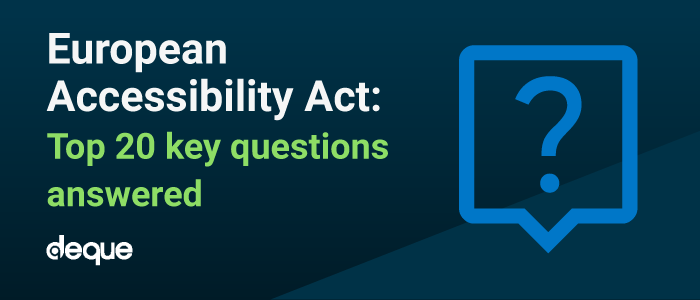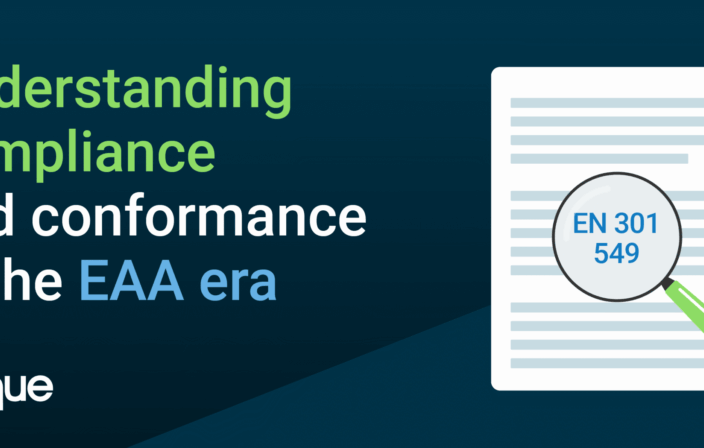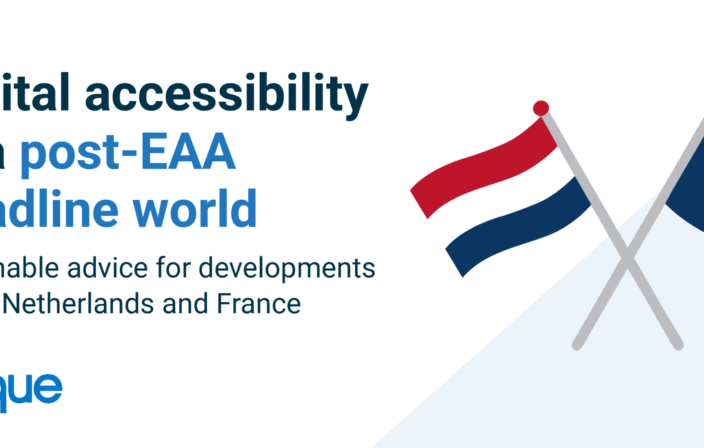The European Accessibility Act is now in effect in all 27 EU countries, and it applies to any business selling into or within the EU—regardless of where the company is based.
Across the globe, everyone from policymakers, managers, and content creators to developers, designers, and accessibility testers has been frantically gathering information and working around the clock to meet the initial compliance requirements. With the June 2025 deadline now behind us, those concerns are more urgent than ever, as the risk increases every day that your business remains non-compliant.
My colleagues and I have been working closely with clients worldwide to answer questions, guide strategy, and support organizational transformation. In addition to our own expert strategic consultants, we’ve partnered with legal experts from international law firms such as Taylor Wessing. By bringing together legal and accessibility expertise, we’re able to help our clients meet immediate requirements while simultaneously preparing for long-term compliance.
In this post, we share answers to some of the most pressing EAA questions we’ve encountered. For businesses needing to accelerate EAA compliance, this is an essential resource.
Of course, if you are also welcome to schedule a consultation if you need assistance with your EAA strategy.
European Accessibility Act 20 FAQs
1. What is the EAA?
The European Accessibility Act (EAA) is an EU directive that sets accessibility requirements for products and services to ensure equal access for people with disabilities. It is a crucial piece of legislation that is now national law in all 27 EU Member States.
2. Are there any exceptions to the EAA?
Microenterprises (defined as a small business with fewer than 10 employees and/or less than €2 Million annual turnover or annual balance sheet total) which provide services are exempted.
3. What is the “disproportionate burden” clause?
The “disproportionate burden” clause within the EAA is designed to balance the goal of widespread accessibility with the practical limitations of some organizations for reasons of proportionality. In certain cases, the cost of compliance may be too high, in which case the economic operator may rely on this exception. The economic operator may use the following for its assessment:
- The ratio of the costs of compliance to the overall costs of the economic operators.
- The estimated costs and benefits in relation to the estimated benefits to persons with disabilities and the ratio of the net costs of compliance to the net turnover.
Companies need to analyze and assess whether this exception would apply, and document the assessment.
4. Who decides if it’s a “disproportionate burden”?
The economic operator needs to make the assessment themselves, document it and must report this to the relevant national authorities. The national authorities will review the assessment and may follow up on this with any investigations. Based on the obligation to notify the authorities of any reliance on the disproportionate burden exception, we would expect that the national authorities may apply enforcement measures (such as fines) towards parties that do not notify the authorities upfront.
5. Do “new products” also include newly released software updates?”
There is some ambiguity in the definition of what is similar (and what is new) within the directive. Our interpretation from a software perspective, especially from the context of continuous development, is that it is hard to state that services remain unaltered. Most developed software with updates or changes would not fit into a grace period regime. All changes entail the risk of introducing new accessibility bugs (and the opportunity to fix ones that exist).
Another way of looking at this is that according to WCAG, any change to a page or a user workflow, even if it’s just a piece of content, needs to comply with accessibility standards.
6. One of the current rules of WCAG is that mobile apps need to be offered in landscape mode. Facebook and Slack, for example, do not allow for landscape mode. Is landscape mode included in the new accessibility requirements of the EAA?
The EAA describes the four principles of accessible websites and mobile applications: Perceivable, Operable, Understandable, and Robust (POUR). Perceivable means that information and user interface components must be presentable to users in ways they can perceive. The POUR principles are the foundation for both the WCAG and the EN 301 594 standard, which both include screen orientation.
You could have pushback from leadership who might argue, “Some other companies aren’t doing this; why should we?” This approach does not insulate you from risk. Focus on what you’re doing now and what you should be doing in the future to ensure compliance and accessibility.
7. If an organization is working towards full compliance but has not yet achieved it as of June 28, 2025, do you anticipate there will be grace and understanding from enforcing regulators, provided the organization has a roadmap towards achieving full compliance?
If an organization was working towards full compliance but did not achieve it by the June 2025 deadline, will enforcing regulators be lenient, provided the organization has a roadmap towards achieving full compliance?
It’s hard to say, but given the magnitude of the task, there may be some grace given. However, do not rely on it. Do your best to achieve compliance as quickly as you can, as regulators may recognize genuine effort.
We urge you to also think about this operationally. With the EAA now the law, how are consumers going to interpret your partial compliance? If they find issues, they can submit complaints to you or the regulator; all of which will slow down your operations. Good intentions in a roadmap don’t prevent this.
8. Do B2C websites that have contact forms, support areas, or product and company information but no e-shop have to be compliant?
While these websites may not fall under the scope of e-commerce, they are likely covered under other digital offerings. The spirit of EAA is about making sure each and every consumer is able to use the entire experience and find their way to the e-commerce section. Partial compliance is not advisable. The EAA is not the type of legislation that you would want to approach with a “bare minimum” mindset—having only some parts of the customer experience in compliance while others are not.
From an operational perspective, the EAA is about removing barriers. Tracking compliance for individual pages or sections can be burdensome and costly. It is more efficient and cost-effective to train your team to make the entire website accessible.
Also, consider the definition of a service: If, in this example, the contact form is used for lead generation or accessing content, it constitutes an exchange, making compliance necessary.
9. Will EN 301 549 apply to entertainment like online video games?
It does. EN 301 5149 is a standard, not a policy. It’s up to policymakers to decide whether it becomes law. EN 301 549 is equally applicable to online video games, just like web and mobile.
10. Would an agency delivering products for their clients after June 28, 2025, be in violation if the product delivered does not comply? Or would the actual client of the agency be in violation? In other words, can a client expect an agency to build accessible software?
From a legal and compliance standpoint, the party providing the service to the end user is the responsible party for EAA compliance, as the economic operator, and the party that potentially would receive the fine for lack of compliance. EAA applies to the brand. As a company you will need to review your agency contracts to ensure that any websites or platforms that are built are EAA compliant. They should be building compliant products anyway, but does your contract contain language to enable this? Remember the spirit of the EAA. Build it accessibly. Show the evidence that it’s accessible. It’s about future-proofing your products.
11. One of the regulations requires that we have accessibility statements on our websites. Do we need to follow EAA’s standards, or can we use our own?
The EAA doesn’t specifically require it, but EU Member States may develop specific regulations.
This can be complicated. For example, if your site serves multiple EU Member States with different statement requirements. This might require a nuanced approach.
12. When do US businesses have to comply?
The directive applies to enterprises outside of the EU that provide services or sell products to consumers within the EU. For instance, US-owned retail websites aimed at consumers in the EU or within a specific country of the EU, or smartphone or e-reader devices sold in the EU by a US-based company. For all countries, the same date applies: June 28, 2025.
13. If a product is released to market already, but is updated with new features or bug fixes in an agile fashion, does that still have the five-year exception?
We believe that an agile, continuously developed online service does not fall under this exception. The system is not the same after those changes, and there is the chance of introducing new accessibility issues (and the opportunity to fix existing ones).
14. Does the EAA apply to internal business/enterprise systems? What about B2B systems?
EAA does not apply to B2B or employee-facing systems, but only to products and services that are placed on the EU market. However, depending on the country, additional regulations may apply to these categories.
Some applications or systems may be used for both internal and external purposes, such as a CMS that is used for an internal intranet and also to publish external content. This would be in scope and would need to comply with EAA.
15. Are accessibility overlays accepted under the EAA?
Overlays don’t make a website accessible. There are some things that they may help you with, but they won’t fix most problems or help you with compliance. Read the Overlay FactSheet website for more context.
In December 2023, the European Commission made an official statement on accessibility overlays and EAA compliance: “Claims that a website can be made fully compliant without manual intervention are not realistic, since no automated tool can cover all the WCAG 2.1 level A and AA criteria. It is even less realistic to expect to detect automatically the additional EN 301549 criteria.”
16. How do these requirements measure up against WCAG 2.1-2.2? If we comply with those guidelines, what else would we need to do?
EN 301 549 currently references WCAG 2.1 AA. A future version will likely be updated to WCAG 2.2 AA.
17. Is the assessment part one of the topics managed by EU Member States?
National authorities will be responsible for carrying out regular compliance checks, including reviewing complaints and following up on any reported non-compliance.
18. Can you define “violation” or give an example?
Any breach of the specific obligations in Annex I of the EAA, such as making certain information available via more than one sensory channel.
19. If a web store merchant in the “10 employees and under” category had a budget for maintaining and enhancing their web shop, but did not earmark any of that budget for enhancing accessibility, would they be in violation?
If they qualify as a micro business (defined as a small business with fewer than 10 employees and/or less than €2 Million annual turnover or annual balance sheet total), the EAA would not apply. However, the EU Member States are obligated to develop guidance for such businesses on how to still ensure accessibility for products and services in the future.
20. What is the definition of an agreement between the consumer and business? Does this need to be financial? Or can it be “free” services such as apps, blogs, and online reservation services?
The “services” definition is used from the Services Directive (2006): “Service” means any self-employed economic activity, normally provided for remuneration, as referred to in Article 50 of the Treaty. Although it states “normally provided for remuneration,” this does not mean that there always has to be a direct fee.
Let Deque ensure you’re up with everything required by the European Accessibility Act 2025
Choose Deque to achieve and maintain EAA compliance.
The European Accessibility Act is now in effect. Does your business need strategic guidance to ensure you’re meeting immediate requirements while also building the right foundation for long-term compliance?
Our market experience gives us unparalleled insight into the common accessibility challenges that enterprises selling into and within the EU face.




